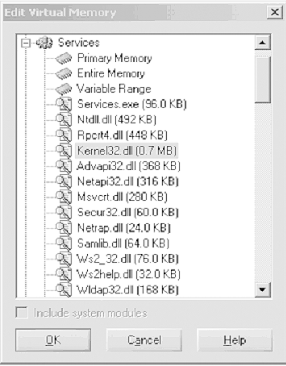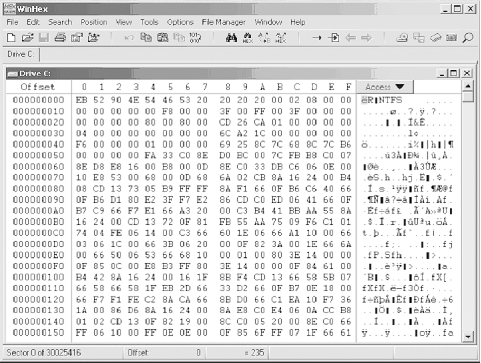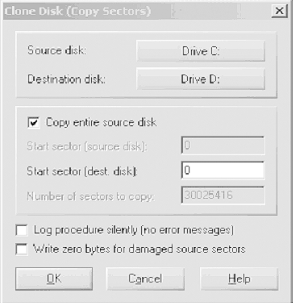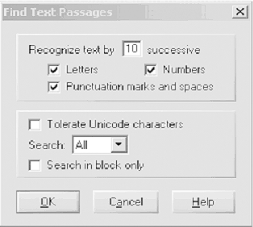22.3 Forensics Tools
| < Day Day Up > |
| Forensics, more than any other discipline, is dependent on tools. Whether you use a $10,000 hardware solution or freeware scripts that you customize yourself, the quality of the tools determines the quality of the analysis. We'll introduce some tools that have proven useful. This list is by no means comprehensive, or even representative. Many other tools may be used to achieve the same goals. The described tools illustrate forensics concepts in some detail and will give you a good starting point. 22.3.1 WinHexFor Windows forensics, start by purchasing WinHex (http://www.winhex.com). Stefan Fleischmann developed WinHex, and it is a masterpiece. It includes a hexadecimal file, disk, and RAM editor (Figure 22-1) ”and that is just the beginning. Figure 22-1. RAM editing with WinHex WinHex is also designed to serve as a low-level cloning, imaging, and disk analysis tool. WinHex is able to clone or image most drive formats, and it supports drives and files of virtually unlimited size (up to terabytes on NTFS volumes ). Figure 22-2 shows a WinHex dump of an NTFS drive. WinHex integrates CRC32 checksums, the common 128-bit MD5 message digest, and even 256-bit strong one-way hashes to ensure data authenticity and secure evidentiary procedure. Figure 22-2. WinHex dump of an NTFS drive WinHex also performs recoveries of hard disks, floppy disks, Zip, Jaz, PC Card ATA flash disks, and more. WinHex is able to create perfect mirrors (including all unused space) of most media types. It incorporates sophisticated, flexible, rapid search functions that you may use to scan entire media (or image files), including slack space, for deleted files and hidden data. Through physical access, this can be accomplished even if a volume is undetectable by the operating system ”e.g., because of an unknown or corrupt filesystem. WinHex's advanced binary editor provides access to all files, clusters, sectors, bytes, nibbles , and bits inside your computer. The operation of creating exact duplicates of one media on another media of the same type is called disk cloning . The duplicate is referred to as a mirror or a physical sector copy . Disk imaging is the term given to creating an exact copy of a disk in the form of an image file. This image file can be stored on different media types for archiving and later restoration. Both cloning and imaging are essential for data recovery and computer investigative purposes. In a data-recovery scenario, it is important to realize that working directly on damaged media can increase the damage. In a forensics scenario, this will render the evidence unusable, not only for litigation, but even for informal discovery investigation. Fortunately, WinHex can clone or image a disk perfectly (Figure 22-3). This enables you to work aggressively on a mirror without making matters worse on the original. Figure 22-3. Cloning a disk with WinHex When imaging to a file, preset a volume size if the target media is smaller than the image file. For example, when using writable CD-ROMs to store an image, you can indicate a 650-MB volume size. This allows you to burn the individual volumes created by WinHex using your CD-burning software. You can choose to recreate an entire image or any portion of that image. For instance, if you want to back up your boot sector, you can extract that sector only. This is also useful in recovery after damage from certain viruses. WinHex produces sector-wise copies of most media types, either to other disks ( clones , mirrors) or to image files, using physical or logical disk access. Image files can optionally be compressed or split into independent archives. WinHex can silently generate logfiles that will note any damaged sectors they encounter during cloning. All readable data is included in the mirror. WinHex also lets you check the integrity and authenticity of image files before restoring them. Although it's more of an antiforensics feature, WinHex can also be used as a disk wiper by rapidly filling every sector of a disk with zero bytes. It can use any byte pattern you like, including random bytes (Figure 22-4). Before recycling or reselling a drive, this effectively removes any traces of files, directories, viruses, proprietary and diagnostic partitions, and so on. WinHex can also securely erase specific files or unused space on a drive only. Optionally, you can fill sectors with a byte pattern that stands for an ASCII string, such as "Bad Sector", on the destination disk before cloning. This makes those parts of the destination disk that have not been overwritten during cloning easily recognizable because of unreadable (physically damaged) source sectors or because of a smaller source drive. (Alternatively, unreadable source sectors can be written as zero-filled sectors on the destination disk.) Figure 22-4. Securely deleting a file WinHex also has expert features that require a specialist license . For example, WinHex can capture slack space and free space. Slack space occurs whenever a file's size is not evenly divisible by the cluster size (which occurs frequently). The unused end of the last cluster allocated to a file will still contain traces of other previously existing files, and will often reveal leads and evidence. WinHex gathers slack space in a file, so you can examine it conveniently and coherently. Free space consists of mostly unused clusters not currently allocated to any file or directory. Because of the inscrutable way that Windows handles (or doesn't handle) memory, free space can also contain traces of other previously existing files. As with slack space, WinHex can gather free space in a file for later examination. Other advanced features of the WinHex specialist license include text filtering and disk cataloging. Text filtering recognizes and gathers text from a file, a disk, or a memory range in a file. This kind of filter considerably reduces the amount of data to process ”for example, if you are looking for leads in the form of text, such as email messages or documents. The target file can easily be split into a user -defined size. Disk cataloging creates a table of existing and deleted files and directories, with user-configurable information such as attributes, all available date and time stamps, size, number of first cluster, MD5 digest, etc. This process systematically examines the contents of a disk. You can also limit the search for files of a certain type by using a filename mask (e.g., *.jpg ). The resulting table can be imported and further processed by databases or MS Excel. Unless the stamps have been spoofed, sorting by date and time stamps results in a good overview of what a disk has been used for at a certain time. In addition, searching for specific attributes (such as the NTFS attribute "encrypted") quickly finds files important in a forensic analysis. WinHex also supports binary searches of all sorts. You can search for any data specified in hexadecimal, ASCII, or EBCDIC in both directions, even generic text passages hidden within binary data (Figure 22-5). WinHex can either stop at each occurrence or simply log the results, aborting only when prompted or if the end of the disk is reached. This is particularly useful for locating certain keywords for investigative purposes. WinHex can also ignore read errors during searches, which proves useful on physically damaged media. WinHex searches in allocated space, slack space, and erased space. Figure 22-5. Searching for text blocks WinHex recently added a feature called parallel search facility . This feature lets you specify a virtually unlimited list of search terms, one per line. The terms are searched for simultaneously , and their occurrences can be archived either in the Position Manager or in a tab-delimited text file, similar to the disk catalog, which can be further processed in MS Excel or any database. WinHex saves the offset of each occurrence, the search term, the name of the file or disk searched, and in the case of a logical drive, the cluster allocation as well (i.e., the name and path of the file that is stored at that particular offset, if any). As a result, you can systematically search an entire hard drive in a single pass for words (all at the same time) such as:
WinHex also supports scripting . Using tailored scripts, you can automate routine steps in your investigation. For example, you may want to concatenate searches for various keywords, or repeatedly save certain clusters into files on other drives. You can also automate detailed operations to run overnight. WinHex also calculates several kinds of checksums and hash values of any file, disk, partition, or part of a disk (256-bit digests). In particular, the MD5 message digest algorithm (128-bit), which produces commonly used unique numeric identifiers (hash values), is incorporated. The hash value of a known file can be compared against the hash value of an unknown file on a seized computer system. Matching values indicate with statistical certainty that the unknown file on the seized system has been authenticated and therefore does not need to be examined further. A final advantage of WinHex is its automatic file recovery feature. It includes two dedicated algorithms for this feature:
|
| < Day Day Up > |
EAN: 2147483647
Pages: 211